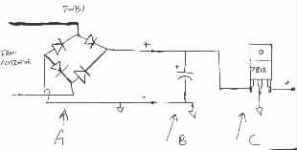Soundguy
Old Timer
- Joined
- Mar 11, 2002
- Messages
- 52,424
- Location
- Central florida
- Tractor
- RK 55HC,ym1700, NH7610S, Ford 8N, 2N, NAA, 660, 850 x2, 541, 950, 941D, 951, 2000, 3000, 4000, 4600, 5000, 740, IH 'C' 'H', CUB, John Deere 'B', allis 'G', case VAC
Ok, for the bridge, radio shack has at least two that will work. One is square, with leads out the bottom corners... a heavy duty device, there is also a small er one that is rectangular with all 4 leads out one of the small sides. Choose either, but double check me to make sure that the one you choose will handle at least 50PIV, and do 5 amps.
Althought I didn't mention it on the schematic, the input to the bridge, choose one line as positive, from the generator, and the other side will be ground from the generator ( or frame as it is most likely common ground )
The capacitor is any electrolytic with a 30v tolerance, preferable 100ufarads or better.
The regulators are a 7812 ( device number, not stock number ), this denotes a negative ground 12v regulator. They will be small, ( TO-220 ) size case, like your thumb nail.
The central tab is connected to the middle pin ( ground ). the left pin is voltage input, the right pin is regulated output.
Get about 7 of them and parallel them together. You can mount them to the metal bottom of a project enclosure if you wish ( it will heat sink them ).
These aren't the absolute best regulators for the job, as they will only handle 1 to 1.5 amps a piece.. but paralled like we have them will be sufficient. If you had a newark or skycraft store near you, you could get a heavier duty model.
I've made thousands of small regulated power supplies using componets like these. They work fairly well.
Between the final regulated output from the circuit, add an automotive style ( bus or blade ) inline fuse holder.. or get fancy, and add a bus style fuse holder to your circuit board if you use a board... Choose probably a 10 amp fuse.
This setup should easilly handle the 5 amp dynamo you have.
Anyway, if you choose this, have fun! It is a fairly simple circuit.
Soundguy
Althought I didn't mention it on the schematic, the input to the bridge, choose one line as positive, from the generator, and the other side will be ground from the generator ( or frame as it is most likely common ground )
The capacitor is any electrolytic with a 30v tolerance, preferable 100ufarads or better.
The regulators are a 7812 ( device number, not stock number ), this denotes a negative ground 12v regulator. They will be small, ( TO-220 ) size case, like your thumb nail.
The central tab is connected to the middle pin ( ground ). the left pin is voltage input, the right pin is regulated output.
Get about 7 of them and parallel them together. You can mount them to the metal bottom of a project enclosure if you wish ( it will heat sink them ).
These aren't the absolute best regulators for the job, as they will only handle 1 to 1.5 amps a piece.. but paralled like we have them will be sufficient. If you had a newark or skycraft store near you, you could get a heavier duty model.
I've made thousands of small regulated power supplies using componets like these. They work fairly well.
Between the final regulated output from the circuit, add an automotive style ( bus or blade ) inline fuse holder.. or get fancy, and add a bus style fuse holder to your circuit board if you use a board... Choose probably a 10 amp fuse.
This setup should easilly handle the 5 amp dynamo you have.
Anyway, if you choose this, have fun! It is a fairly simple circuit.
Soundguy


